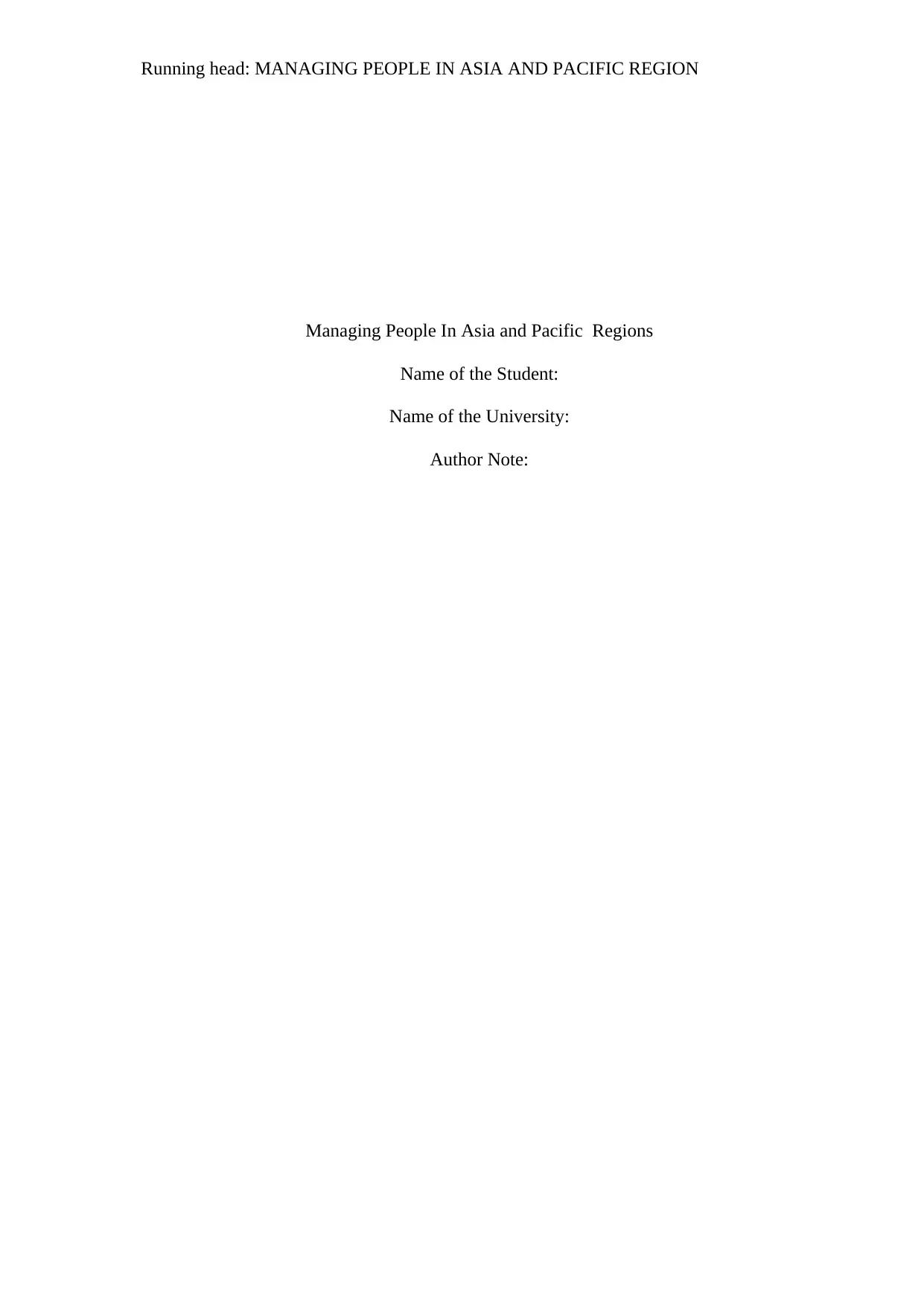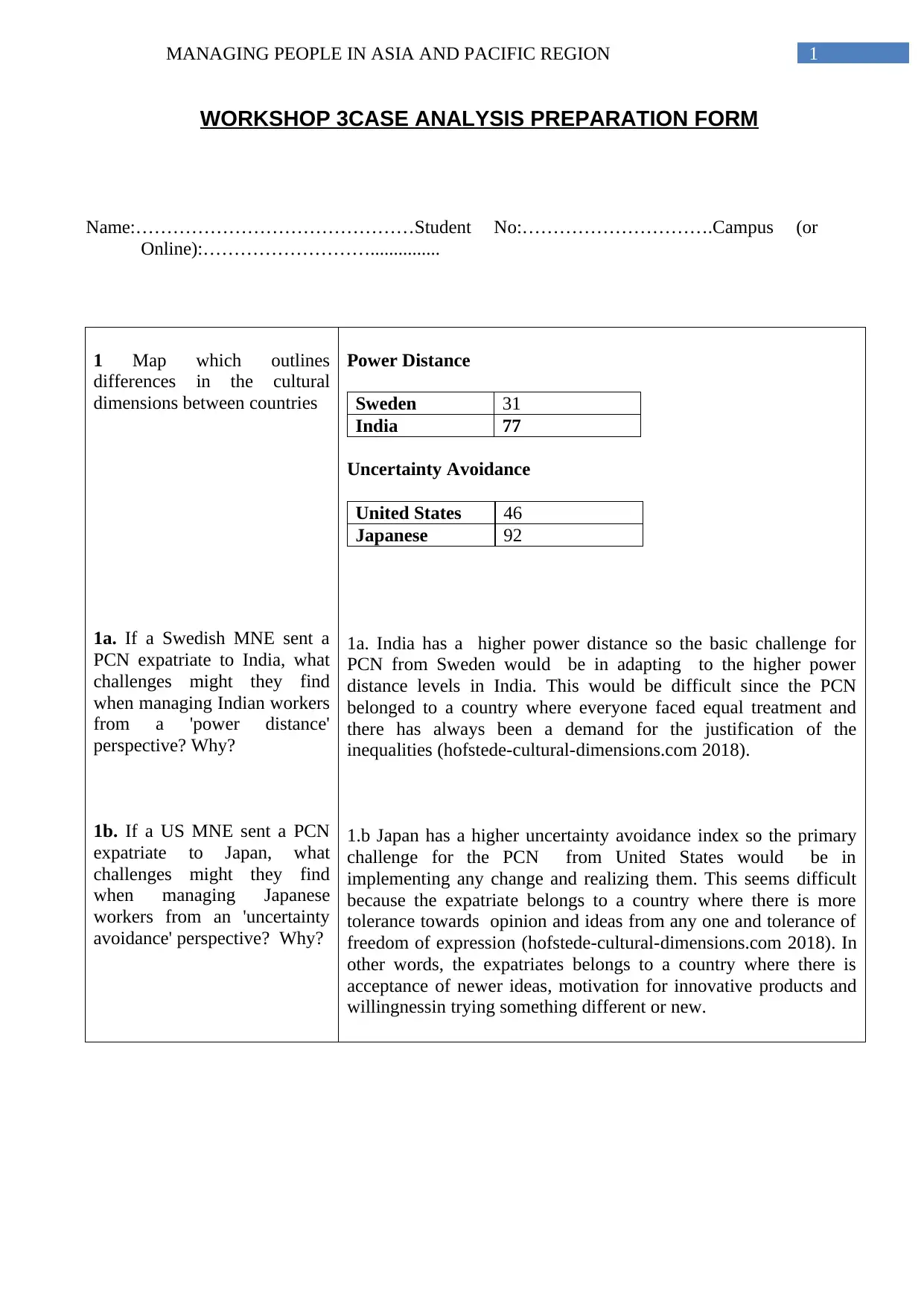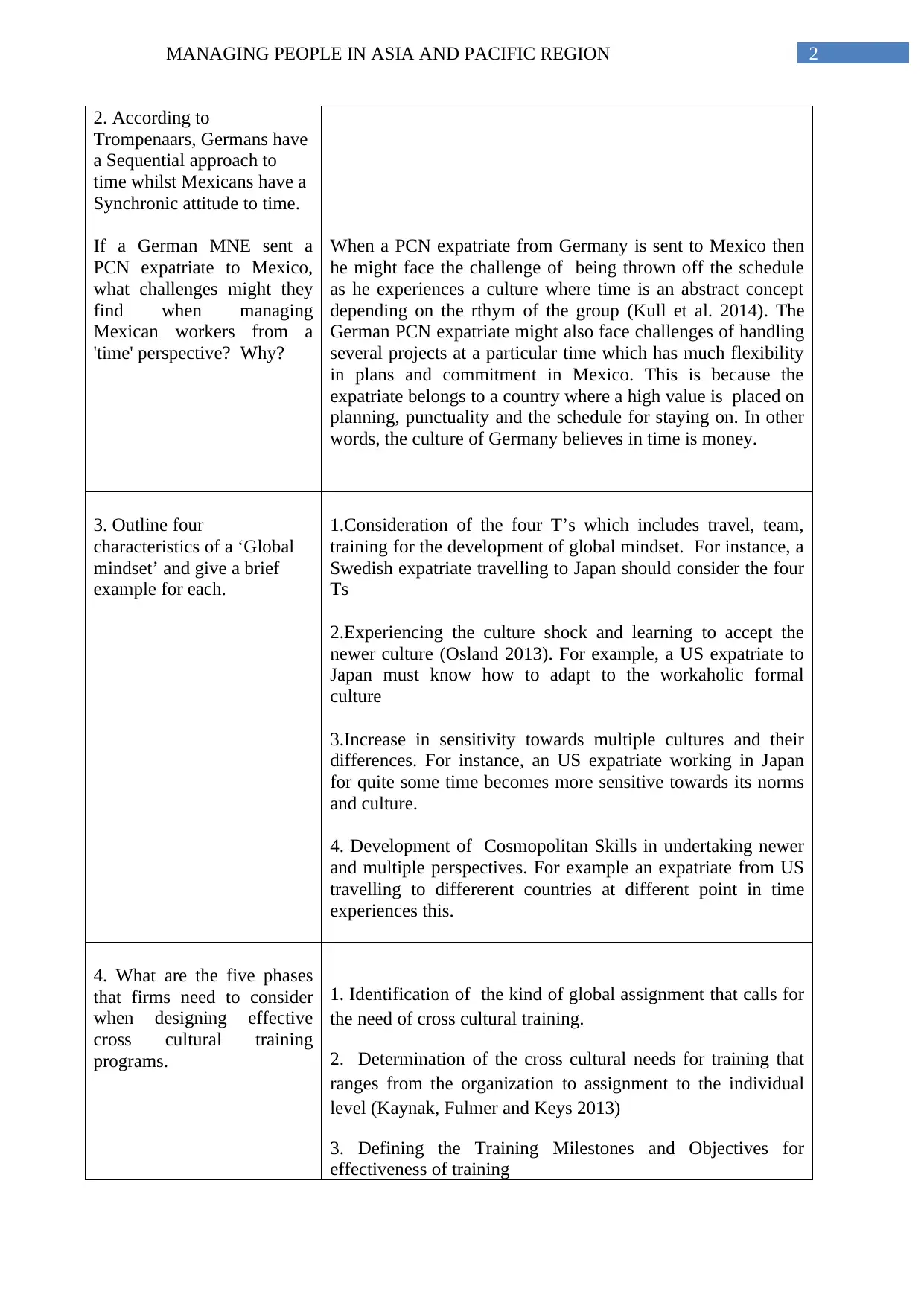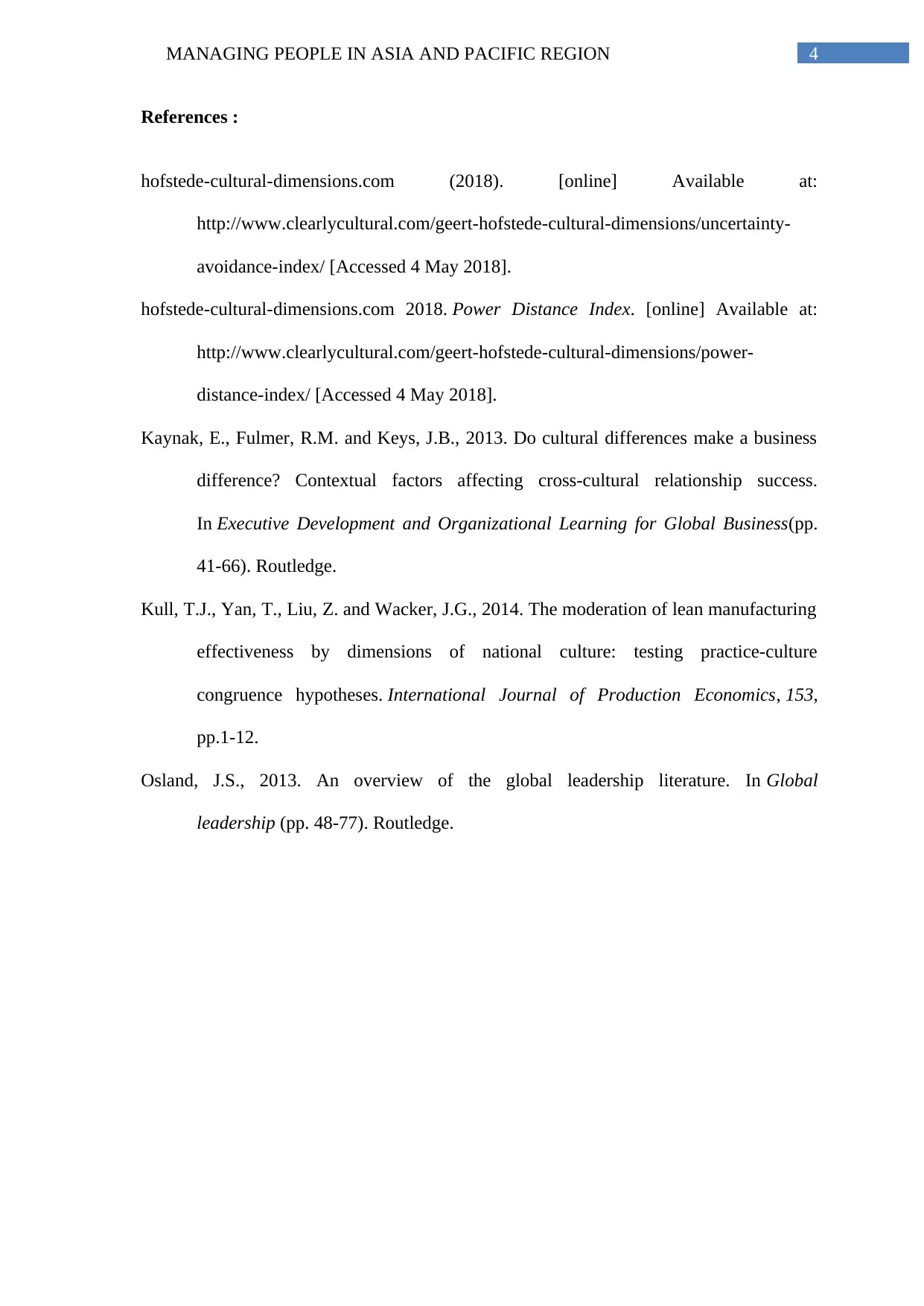University Name: Managing People in Asia and Pacific Region Analysis
VerifiedAdded on 2021/05/31
|5
|886
|474
Report
AI Summary
This report analyzes the challenges of managing people in the Asia and Pacific regions, focusing on cross-cultural management. It examines the impact of cultural dimensions, such as power distance and uncertainty avoidance, on managing expatriates from different countries. The report uses Hofstede's cultural dimensions and Trompenaars' time orientation to illustrate these challenges. It explores the characteristics of a global mindset and provides examples. Finally, it outlines the five phases of effective cross-cultural training programs. The report emphasizes the importance of understanding cultural differences for successful international business operations and leadership.

Running head: MANAGING PEOPLE IN ASIA AND PACIFIC REGION
Managing People In Asia and Pacific Regions
Name of the Student:
Name of the University:
Author Note:
Managing People In Asia and Pacific Regions
Name of the Student:
Name of the University:
Author Note:
Paraphrase This Document
Need a fresh take? Get an instant paraphrase of this document with our AI Paraphraser

1MANAGING PEOPLE IN ASIA AND PACIFIC REGION
WORKSHOP 3CASE ANALYSIS PREPARATION FORM
Name:………………………………………Student No:………………………….Campus (or
Online):………………………...............
1 Map which outlines
differences in the cultural
dimensions between countries
1a. If a Swedish MNE sent a
PCN expatriate to India, what
challenges might they find
when managing Indian workers
from a 'power distance'
perspective? Why?
1b. If a US MNE sent a PCN
expatriate to Japan, what
challenges might they find
when managing Japanese
workers from an 'uncertainty
avoidance' perspective? Why?
Power Distance
Sweden 31
India 77
Uncertainty Avoidance
United States 46
Japanese 92
1a. India has a higher power distance so the basic challenge for
PCN from Sweden would be in adapting to the higher power
distance levels in India. This would be difficult since the PCN
belonged to a country where everyone faced equal treatment and
there has always been a demand for the justification of the
inequalities (hofstede-cultural-dimensions.com 2018).
1.b Japan has a higher uncertainty avoidance index so the primary
challenge for the PCN from United States would be in
implementing any change and realizing them. This seems difficult
because the expatriate belongs to a country where there is more
tolerance towards opinion and ideas from any one and tolerance of
freedom of expression (hofstede-cultural-dimensions.com 2018). In
other words, the expatriates belongs to a country where there is
acceptance of newer ideas, motivation for innovative products and
willingnessin trying something different or new.
WORKSHOP 3CASE ANALYSIS PREPARATION FORM
Name:………………………………………Student No:………………………….Campus (or
Online):………………………...............
1 Map which outlines
differences in the cultural
dimensions between countries
1a. If a Swedish MNE sent a
PCN expatriate to India, what
challenges might they find
when managing Indian workers
from a 'power distance'
perspective? Why?
1b. If a US MNE sent a PCN
expatriate to Japan, what
challenges might they find
when managing Japanese
workers from an 'uncertainty
avoidance' perspective? Why?
Power Distance
Sweden 31
India 77
Uncertainty Avoidance
United States 46
Japanese 92
1a. India has a higher power distance so the basic challenge for
PCN from Sweden would be in adapting to the higher power
distance levels in India. This would be difficult since the PCN
belonged to a country where everyone faced equal treatment and
there has always been a demand for the justification of the
inequalities (hofstede-cultural-dimensions.com 2018).
1.b Japan has a higher uncertainty avoidance index so the primary
challenge for the PCN from United States would be in
implementing any change and realizing them. This seems difficult
because the expatriate belongs to a country where there is more
tolerance towards opinion and ideas from any one and tolerance of
freedom of expression (hofstede-cultural-dimensions.com 2018). In
other words, the expatriates belongs to a country where there is
acceptance of newer ideas, motivation for innovative products and
willingnessin trying something different or new.

2MANAGING PEOPLE IN ASIA AND PACIFIC REGION
2. According to
Trompenaars, Germans have
a Sequential approach to
time whilst Mexicans have a
Synchronic attitude to time.
If a German MNE sent a
PCN expatriate to Mexico,
what challenges might they
find when managing
Mexican workers from a
'time' perspective? Why?
When a PCN expatriate from Germany is sent to Mexico then
he might face the challenge of being thrown off the schedule
as he experiences a culture where time is an abstract concept
depending on the rthym of the group (Kull et al. 2014). The
German PCN expatriate might also face challenges of handling
several projects at a particular time which has much flexibility
in plans and commitment in Mexico. This is because the
expatriate belongs to a country where a high value is placed on
planning, punctuality and the schedule for staying on. In other
words, the culture of Germany believes in time is money.
3. Outline four
characteristics of a ‘Global
mindset’ and give a brief
example for each.
1.Consideration of the four T’s which includes travel, team,
training for the development of global mindset. For instance, a
Swedish expatriate travelling to Japan should consider the four
Ts
2.Experiencing the culture shock and learning to accept the
newer culture (Osland 2013). For example, a US expatriate to
Japan must know how to adapt to the workaholic formal
culture
3.Increase in sensitivity towards multiple cultures and their
differences. For instance, an US expatriate working in Japan
for quite some time becomes more sensitive towards its norms
and culture.
4. Development of Cosmopolitan Skills in undertaking newer
and multiple perspectives. For example an expatriate from US
travelling to differerent countries at different point in time
experiences this.
4. What are the five phases
that firms need to consider
when designing effective
cross cultural training
programs.
1. Identification of the kind of global assignment that calls for
the need of cross cultural training.
2. Determination of the cross cultural needs for training that
ranges from the organization to assignment to the individual
level (Kaynak, Fulmer and Keys 2013)
3. Defining the Training Milestones and Objectives for
effectiveness of training
2. According to
Trompenaars, Germans have
a Sequential approach to
time whilst Mexicans have a
Synchronic attitude to time.
If a German MNE sent a
PCN expatriate to Mexico,
what challenges might they
find when managing
Mexican workers from a
'time' perspective? Why?
When a PCN expatriate from Germany is sent to Mexico then
he might face the challenge of being thrown off the schedule
as he experiences a culture where time is an abstract concept
depending on the rthym of the group (Kull et al. 2014). The
German PCN expatriate might also face challenges of handling
several projects at a particular time which has much flexibility
in plans and commitment in Mexico. This is because the
expatriate belongs to a country where a high value is placed on
planning, punctuality and the schedule for staying on. In other
words, the culture of Germany believes in time is money.
3. Outline four
characteristics of a ‘Global
mindset’ and give a brief
example for each.
1.Consideration of the four T’s which includes travel, team,
training for the development of global mindset. For instance, a
Swedish expatriate travelling to Japan should consider the four
Ts
2.Experiencing the culture shock and learning to accept the
newer culture (Osland 2013). For example, a US expatriate to
Japan must know how to adapt to the workaholic formal
culture
3.Increase in sensitivity towards multiple cultures and their
differences. For instance, an US expatriate working in Japan
for quite some time becomes more sensitive towards its norms
and culture.
4. Development of Cosmopolitan Skills in undertaking newer
and multiple perspectives. For example an expatriate from US
travelling to differerent countries at different point in time
experiences this.
4. What are the five phases
that firms need to consider
when designing effective
cross cultural training
programs.
1. Identification of the kind of global assignment that calls for
the need of cross cultural training.
2. Determination of the cross cultural needs for training that
ranges from the organization to assignment to the individual
level (Kaynak, Fulmer and Keys 2013)
3. Defining the Training Milestones and Objectives for
effectiveness of training
⊘ This is a preview!⊘
Do you want full access?
Subscribe today to unlock all pages.

Trusted by 1+ million students worldwide

3MANAGING PEOPLE IN ASIA AND PACIFIC REGION
4. Development and delivery of the cross cultural training
program
5. Creation of Tracking Metrics for Monitoring the Progress of
Training
Word count:……350………………
4. Development and delivery of the cross cultural training
program
5. Creation of Tracking Metrics for Monitoring the Progress of
Training
Word count:……350………………
Paraphrase This Document
Need a fresh take? Get an instant paraphrase of this document with our AI Paraphraser

4MANAGING PEOPLE IN ASIA AND PACIFIC REGION
References :
hofstede-cultural-dimensions.com (2018). [online] Available at:
http://www.clearlycultural.com/geert-hofstede-cultural-dimensions/uncertainty-
avoidance-index/ [Accessed 4 May 2018].
hofstede-cultural-dimensions.com 2018. Power Distance Index. [online] Available at:
http://www.clearlycultural.com/geert-hofstede-cultural-dimensions/power-
distance-index/ [Accessed 4 May 2018].
Kaynak, E., Fulmer, R.M. and Keys, J.B., 2013. Do cultural differences make a business
difference? Contextual factors affecting cross-cultural relationship success.
In Executive Development and Organizational Learning for Global Business(pp.
41-66). Routledge.
Kull, T.J., Yan, T., Liu, Z. and Wacker, J.G., 2014. The moderation of lean manufacturing
effectiveness by dimensions of national culture: testing practice-culture
congruence hypotheses. International Journal of Production Economics, 153,
pp.1-12.
Osland, J.S., 2013. An overview of the global leadership literature. In Global
leadership (pp. 48-77). Routledge.
References :
hofstede-cultural-dimensions.com (2018). [online] Available at:
http://www.clearlycultural.com/geert-hofstede-cultural-dimensions/uncertainty-
avoidance-index/ [Accessed 4 May 2018].
hofstede-cultural-dimensions.com 2018. Power Distance Index. [online] Available at:
http://www.clearlycultural.com/geert-hofstede-cultural-dimensions/power-
distance-index/ [Accessed 4 May 2018].
Kaynak, E., Fulmer, R.M. and Keys, J.B., 2013. Do cultural differences make a business
difference? Contextual factors affecting cross-cultural relationship success.
In Executive Development and Organizational Learning for Global Business(pp.
41-66). Routledge.
Kull, T.J., Yan, T., Liu, Z. and Wacker, J.G., 2014. The moderation of lean manufacturing
effectiveness by dimensions of national culture: testing practice-culture
congruence hypotheses. International Journal of Production Economics, 153,
pp.1-12.
Osland, J.S., 2013. An overview of the global leadership literature. In Global
leadership (pp. 48-77). Routledge.
1 out of 5
Your All-in-One AI-Powered Toolkit for Academic Success.
+13062052269
info@desklib.com
Available 24*7 on WhatsApp / Email
![[object Object]](/_next/static/media/star-bottom.7253800d.svg)
Unlock your academic potential
Copyright © 2020–2025 A2Z Services. All Rights Reserved. Developed and managed by ZUCOL.